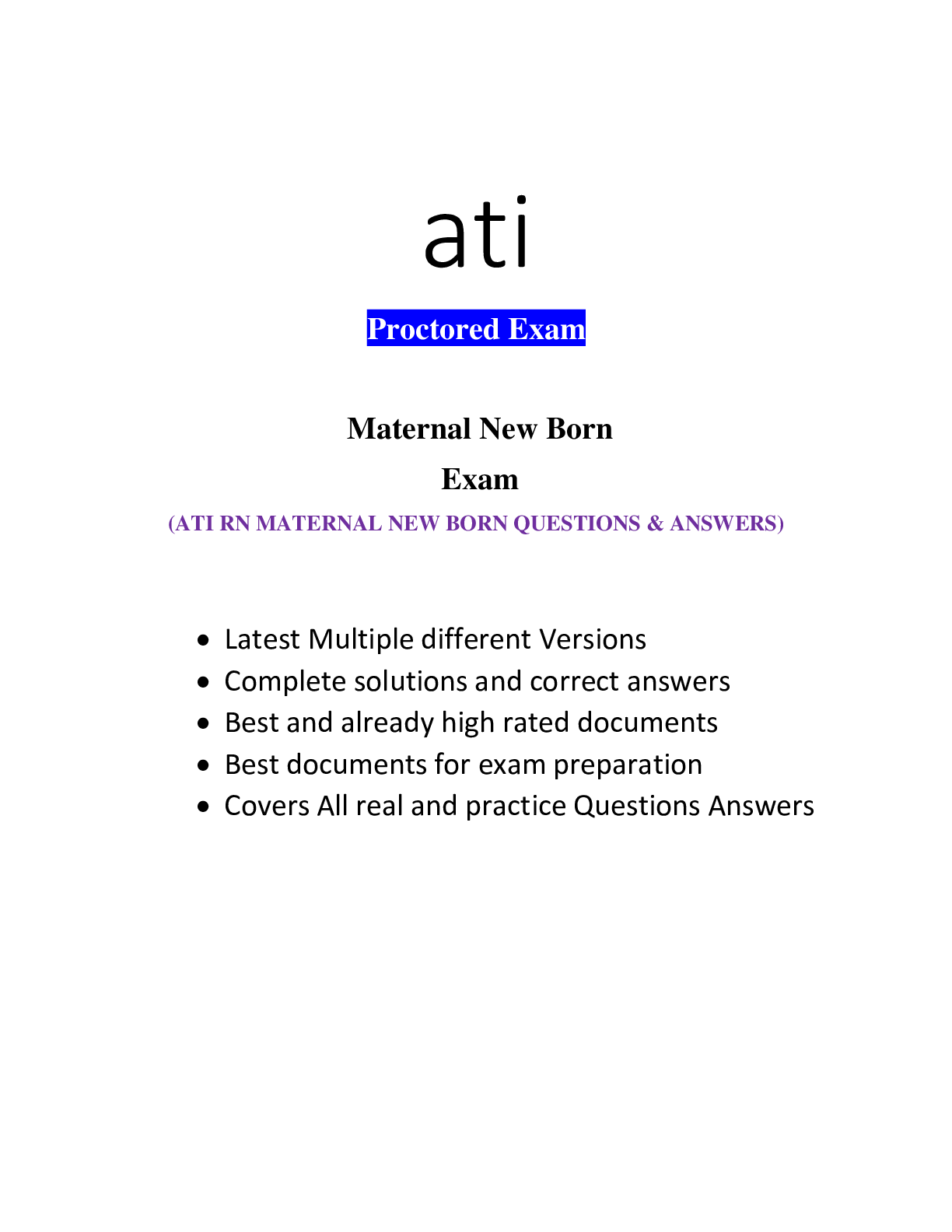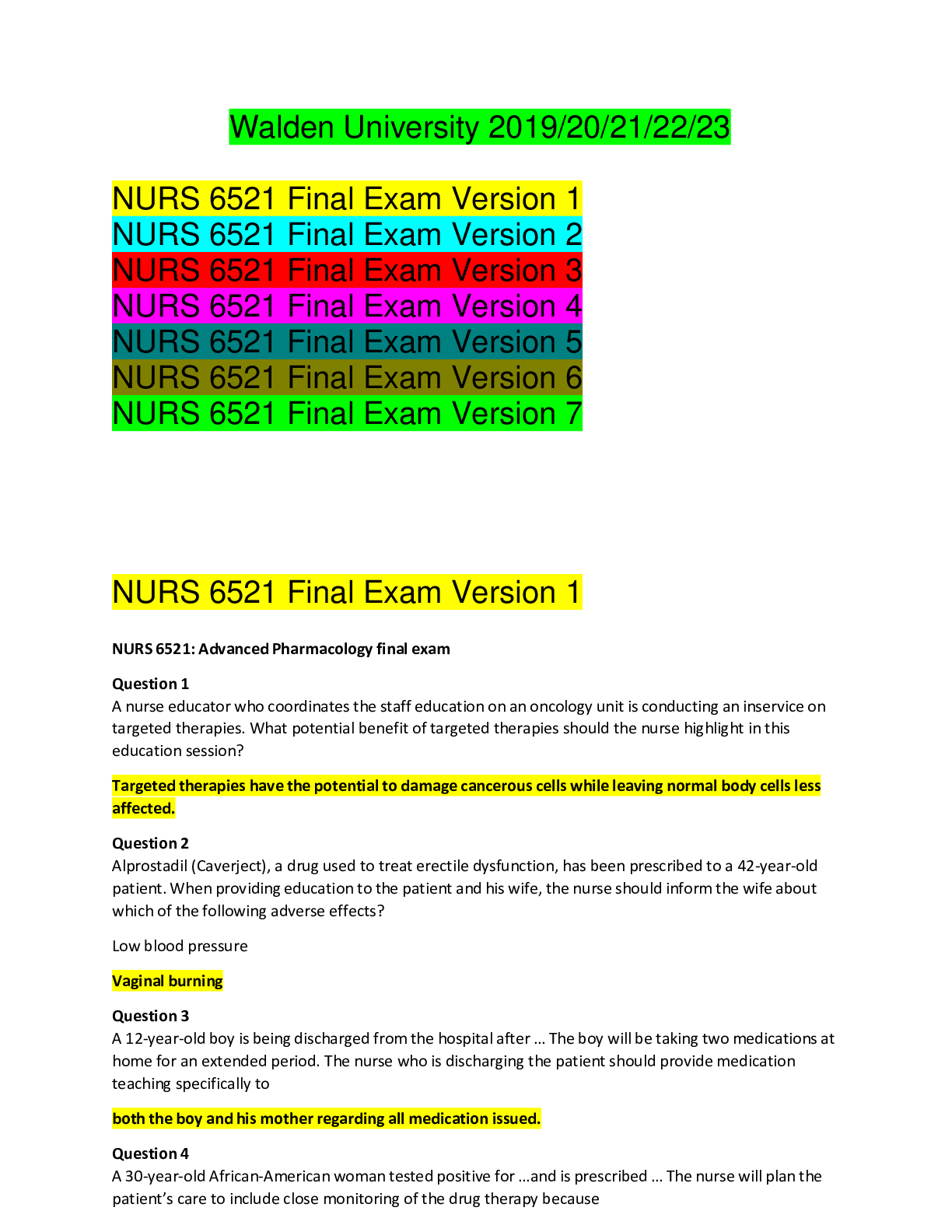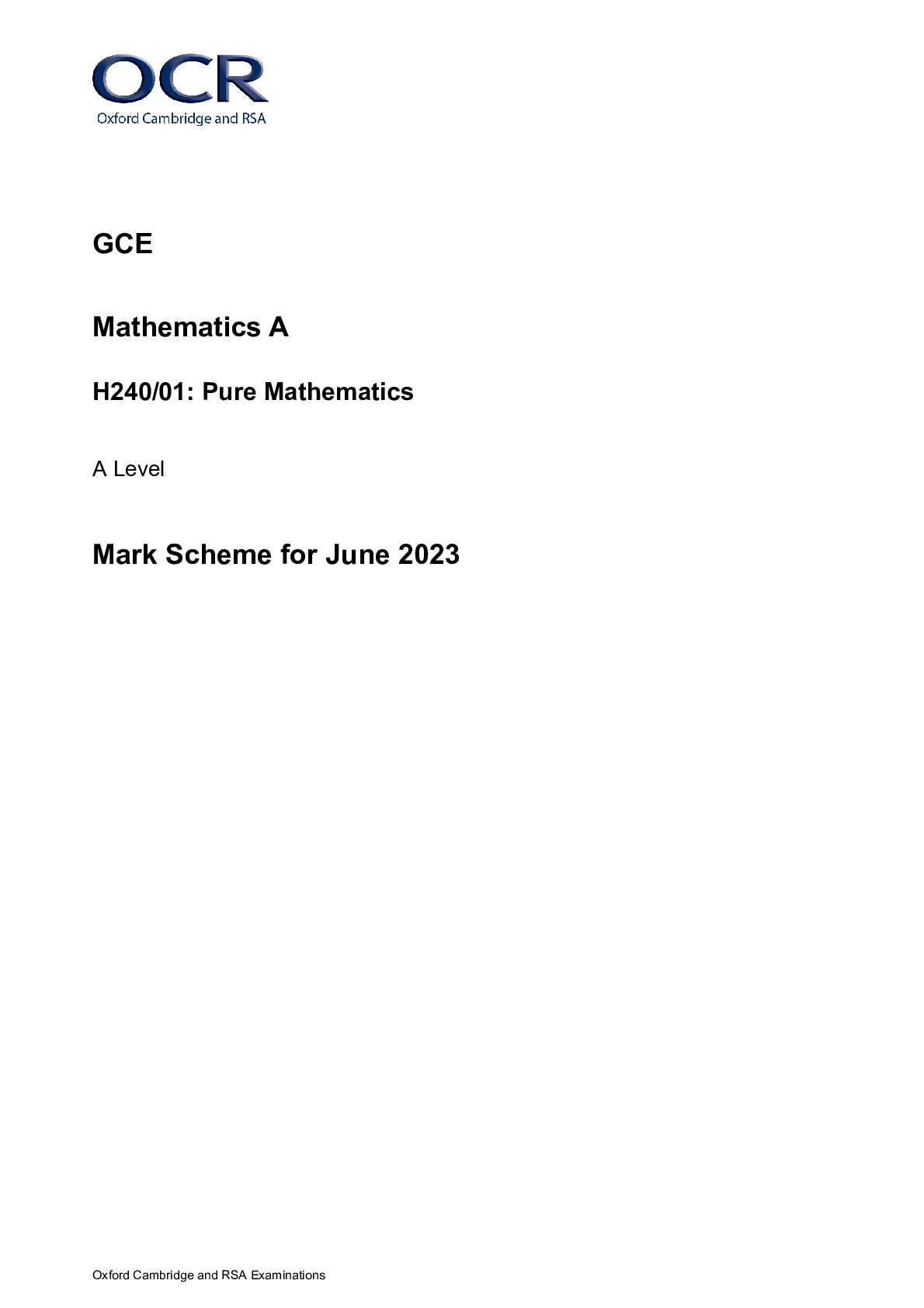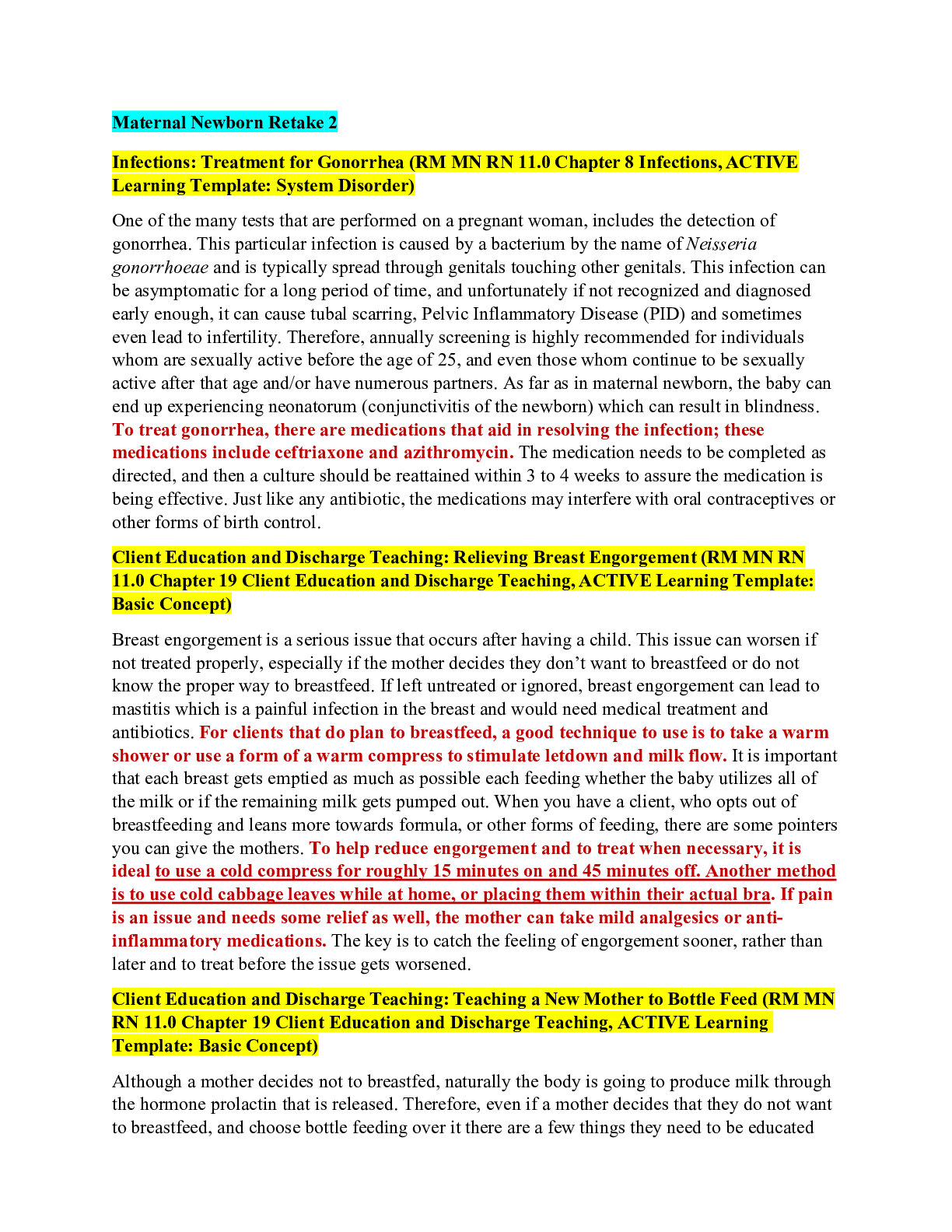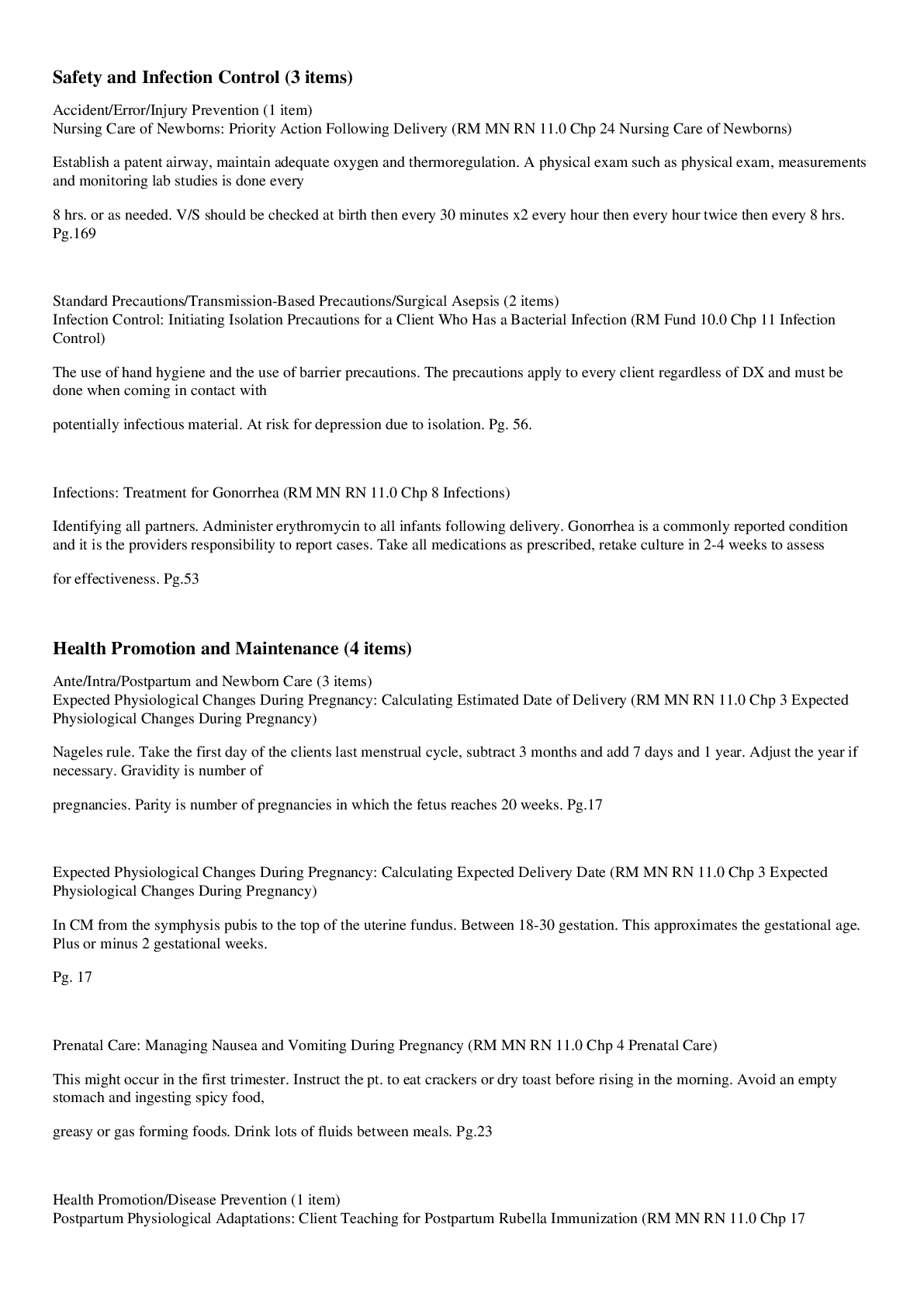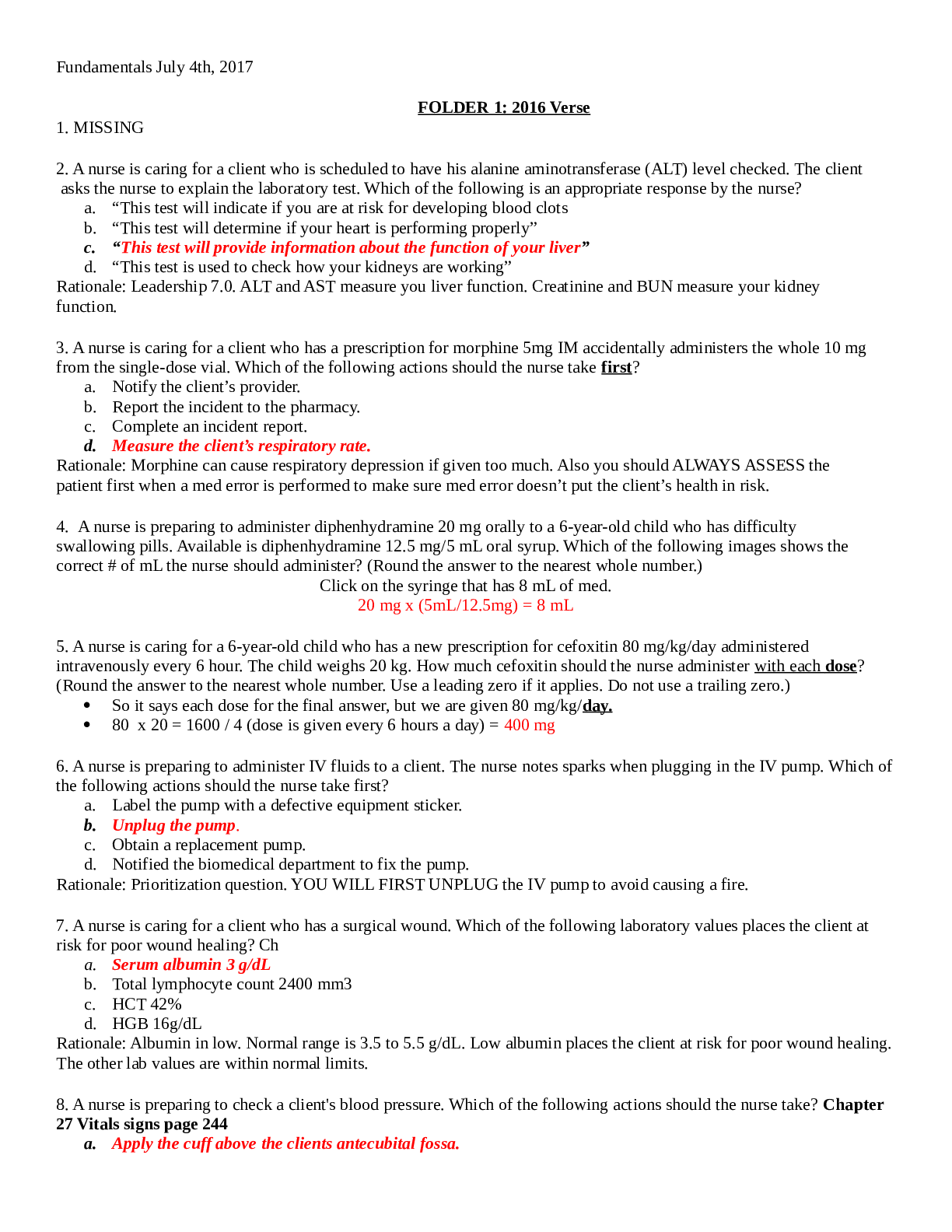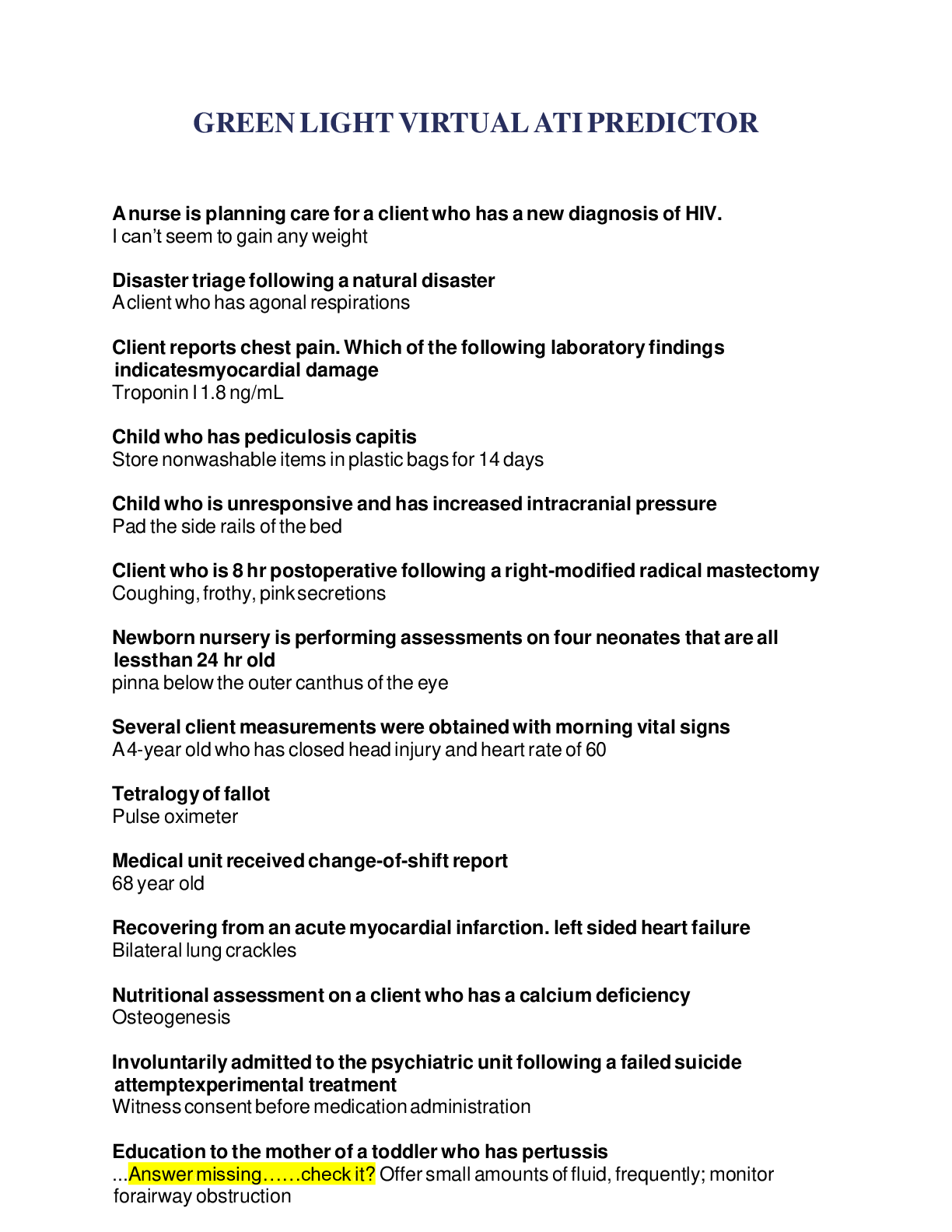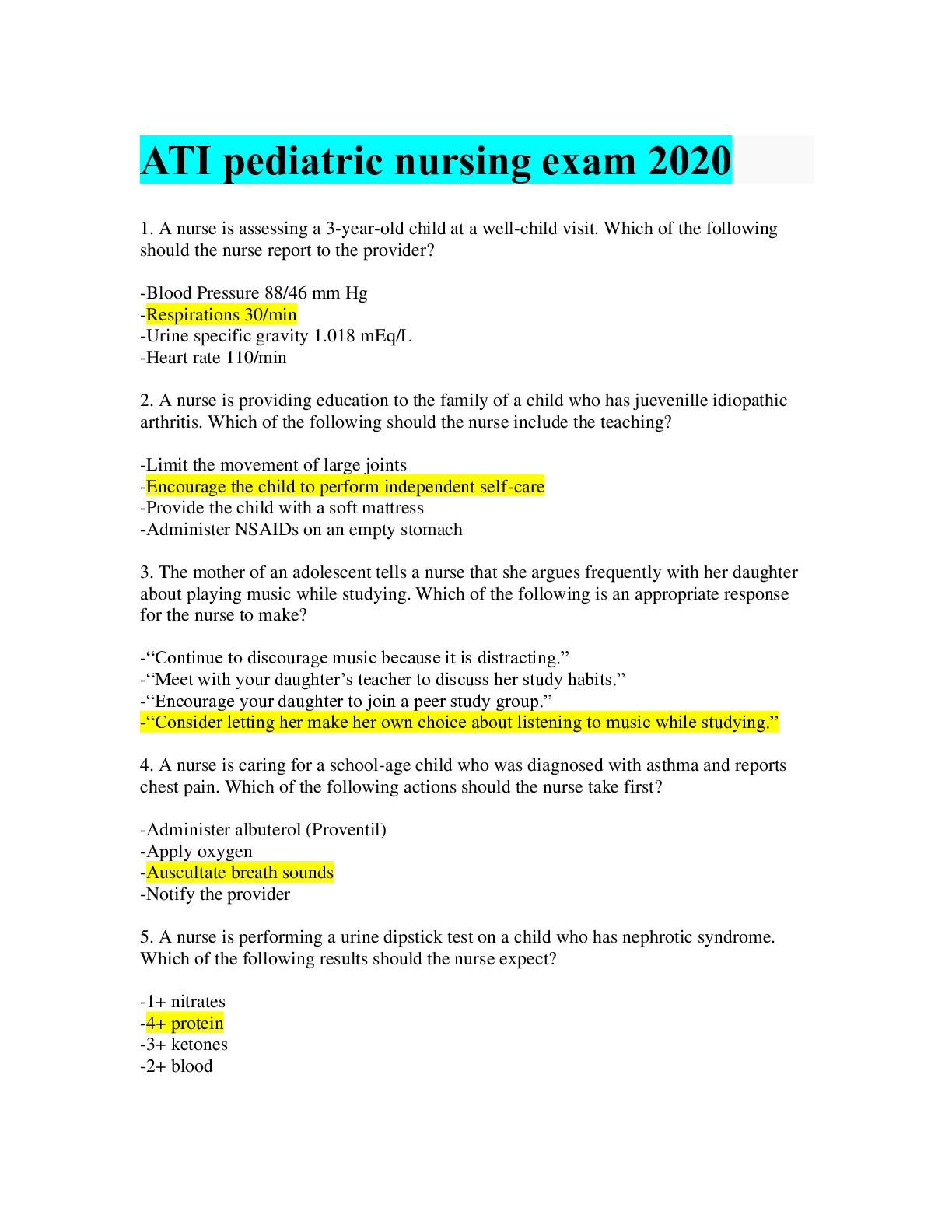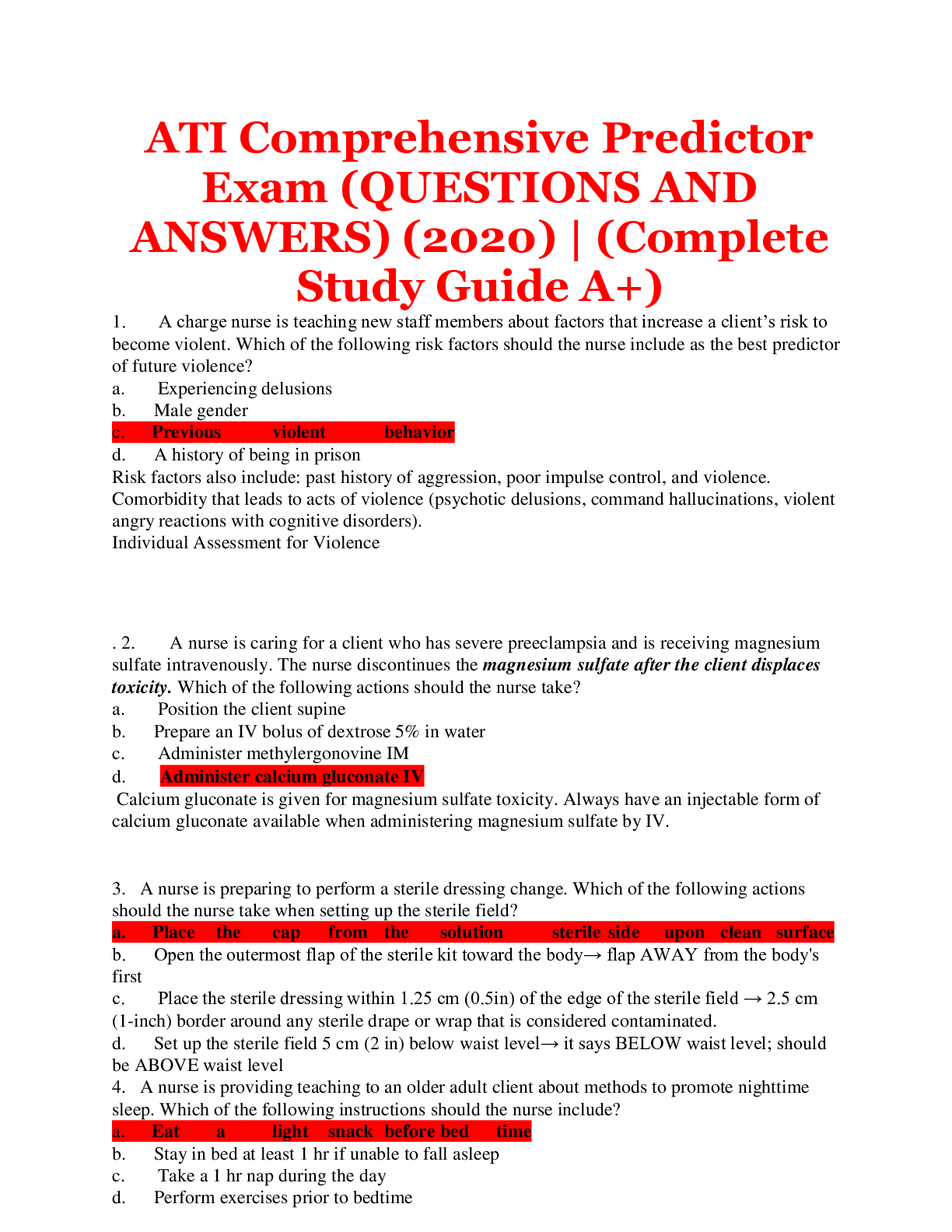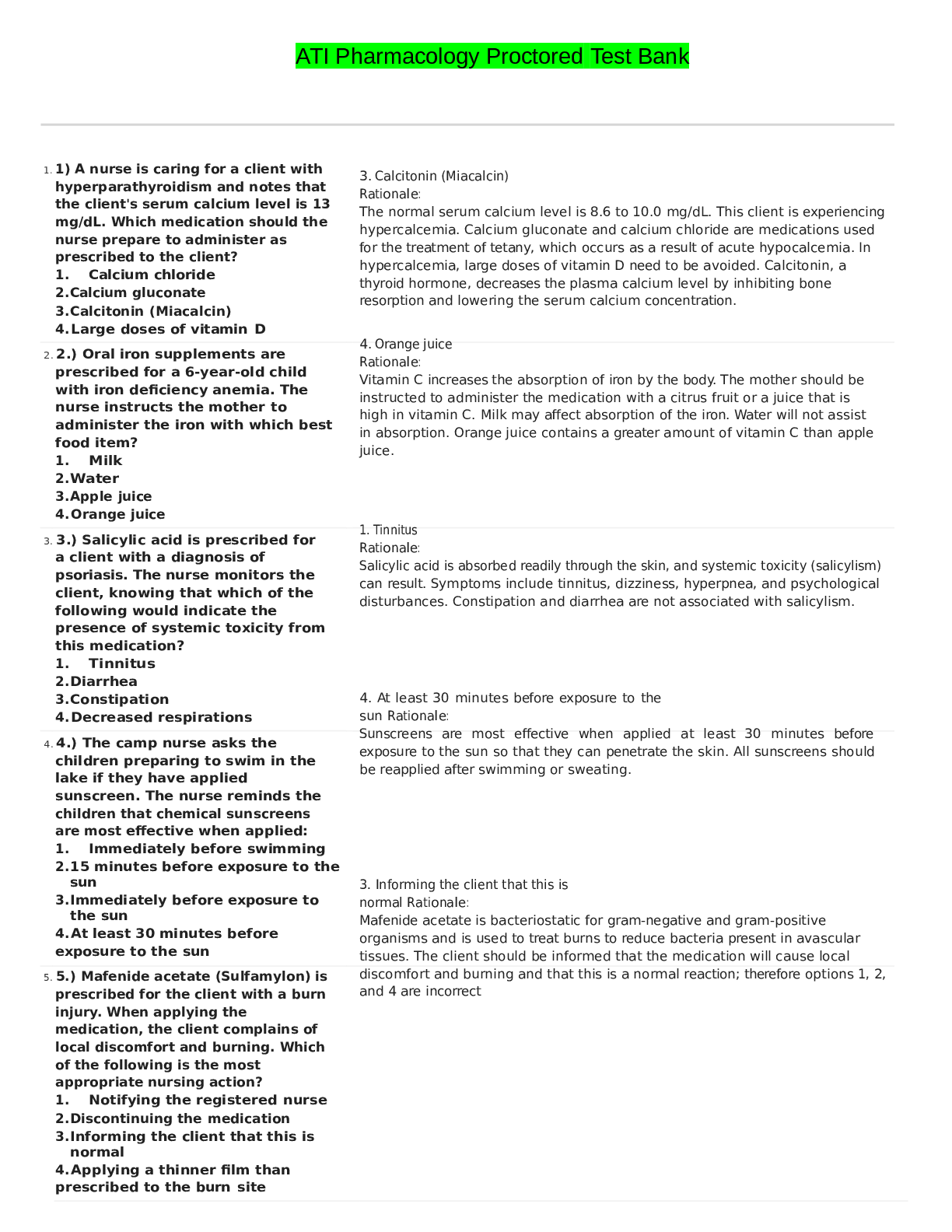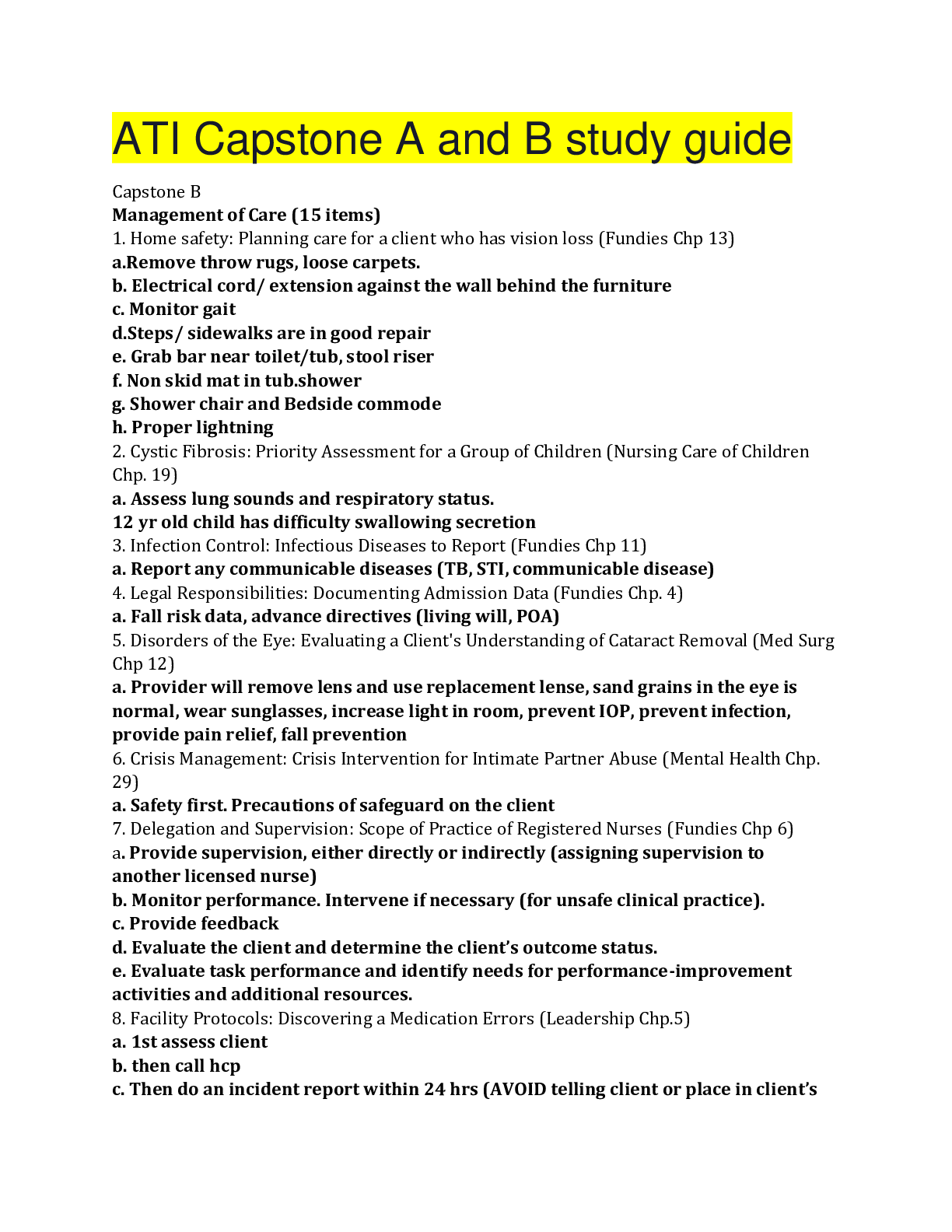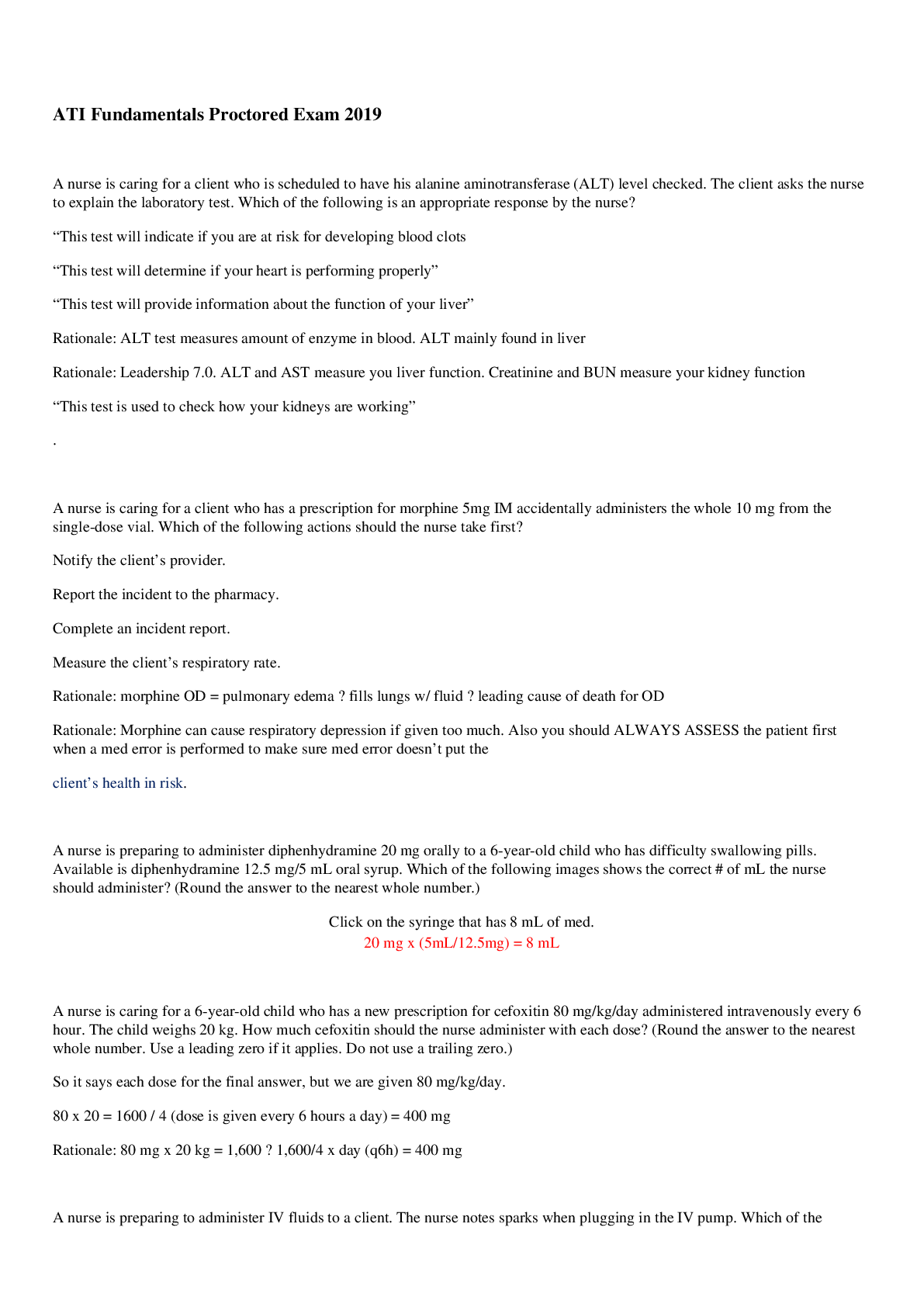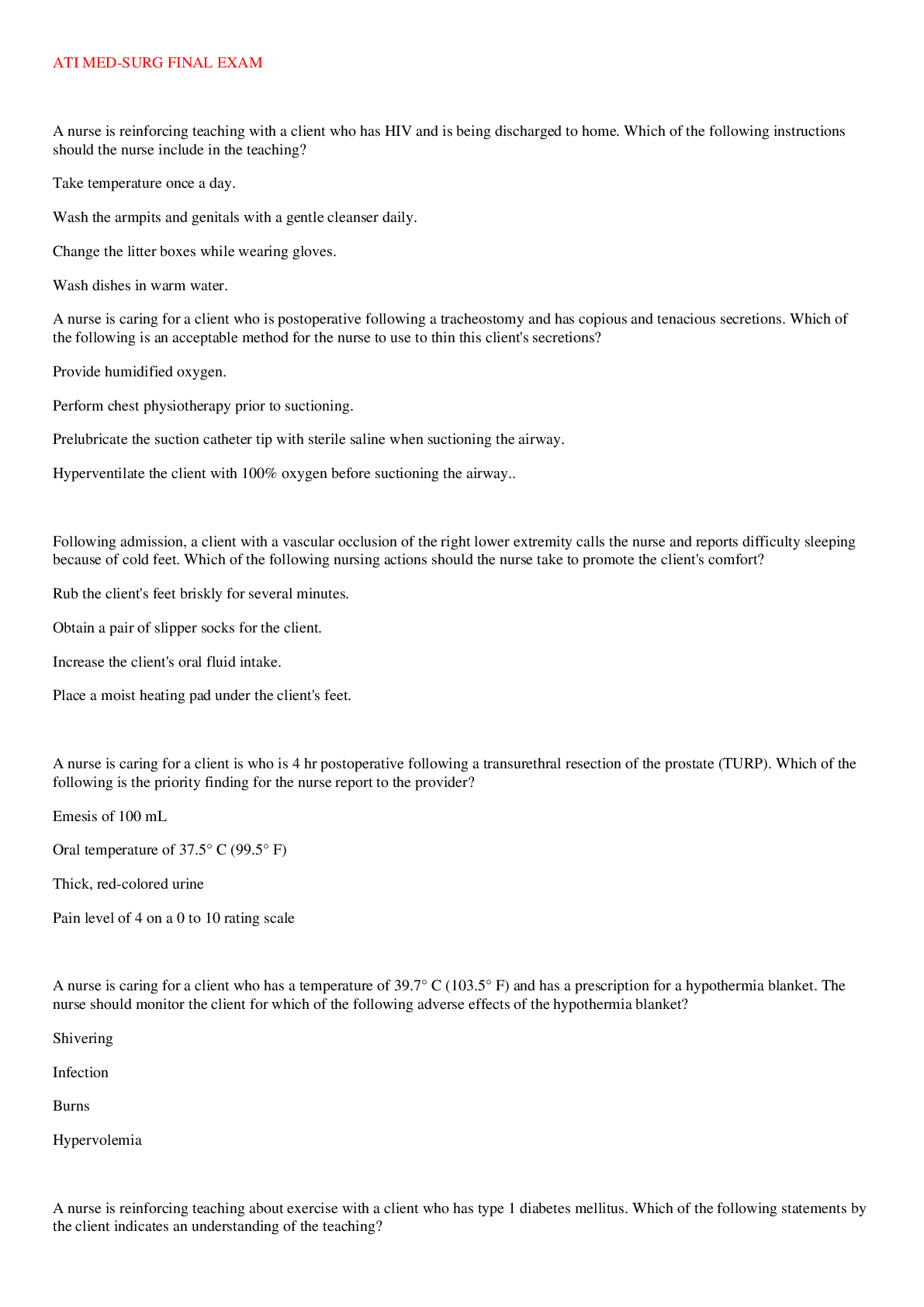*NURSING > QUESTIONS and ANSWERS > ATI PEDIATRIC PROCTOR PEDS 3 EXAM( COMPLETE 70 QUESTIONS & ANSWERS). (All)
ATI PEDIATRIC PROCTOR PEDS 3 EXAM( COMPLETE 70 QUESTIONS & ANSWERS).
Document Content and Description Below
Peds 3 70 Written questions 1. A nurse is preparing to perform peritoneal dialysis for a child who has an elevated serum creatinine level. After explaining the procedure, which of the following action... s should the nurse plan to take? Obtain the child's weight 2. A nurse is providing discharge teaching to the parents of a toddler who has iron deficiency anemia and a new prescription for ferrous sulfate elixir. Which of the following instructions should the nurse include? Administer this medication to your child with a dropper. 3. A nurse is administering albuterol by metered dose inhaler for a preschool-age child who is experiencing an asthma exacerbation. Which of the following findings should the nurse report to the provider? Intercostal retractions 4. A nurse is caring for a 4-year-old child who has meningitis and is receiving gentamicin. Which of the following laboratory values should the nurse report to the provider? Creatinine 1.4 mg/dL 5. A nurse is preparing to administer cephalexin 25 mg/kg PO to a child who has otitis media and weighs 22 kg (48.5lb). Available is cephalexin solution 250 mg/5mL. How many mL should the nurse administer? (Round to the nearest whole number. Use a leading zero if it applies. Do not use a trailing zero.) 11 mL 6. A nurse is providing dietary teaching to a parent of a 10-month-old infant who has phenylketonuria. Which of the following responses by the parent indicates an understanding of the teaching? I will steam carrots and cut them into small pieces for her. 7. A nurse is providing discharge teaching to the parents of a school-age child who has cystic fibrosis. Which of the following responses by the parents indicates an understanding of the teaching? "I will give my child pancreatic enzymes with snacks and meals." 8. A nurse is caring for a preschooler who has a brain tumor. Which of the following findings is the priority for the nurse to report to the provider? Diplopia 9. A nurse is providing education about dietary modifications to the parents of a school-age child who has glomerulonephritis. Which of the following information should the nurse include in the teaching? Decrease the child's sodium intake. 10. A nurse is assessing an adolescent who has type 1 diabetes mellitus. Which of the following findings is the nurse's priority? HbA1c 11.5% 11. A nurse is providing teaching to the parents of a school-age child newly diagnosed with a seizure disorder. The nurse should teach the parents to take which of the following actions during a seizure? Clear the area of hard objects 12. A nurse in an emergency department is caring for a child following an overdose of acetylsalicylic acid. Which of the following mediations should the nurse plan to administer? Phytonadione 13. A nurse is providing teaching to the parents of a preschool-age child who has celiac disease. Which of the following instructions should the nurse include? Your child will be on a gluten-free diet for the rest of her life. 14. A nurse is teaching a parent of a 10-month-old infant about home safety. Which of the following instructions should the nurse include in the teaching? (Select all that apply) Place gates at the top and bottom of the stairs and Ensure the crib mattress is in the lowest position 15. A nurse is prioritizing care for four clients. Which of the following clients should the nurse assess first? An adolescent who has a sickle cell anemia and slurred speech . 16. A nurse is providing teaching to the parent of a school-age child who has diabetes mellitus about managing diabetes during illness. Which of the following statement by the parent indicates an understanding of the teaching? I will increase the amount of fluids I offer my children 17. A nurse is reviewing the medical record of a 24-month-old child who has acute lymphocytic leukemia. Which of the following actions should the nurse take? (Click the exhibit button for additional information about the client. There are three tabs that contain separate categories of data.) Initiate bleeding precaution 18. A nurse is caring for an infant who has tetralogy of fallot and is having a hypercyanotic episode after crying. Which of the following intervention should the nurse implement? Place the infant in the knee-chest position. 19. A nurse is assessing a toddler who has a history of lead poisoning. Which of the following actions should the nurse take? Perform development testing for delays. 20. A nurse is assessing a 6-month-old infant who has respiratory syncytial virus. The nurse should immediately report which of the following findings to the provider? Pharyngitis 21. A nurse in an emergency department is caring for a child who weighs 18 kg (39.7 lb) and indigested six 500 mg acetaminophen tablets 4 hr ago. Which of the following actions should the nurse take? Prepare to give oral N-acetylcysteine 22. A nurse is providing discharge instructions to the parents of a toddler who has heart failure and a new prescription for digoxin. Which of the following statements indicate an understanding of the instructions? We will wait to give the medication at the next scheduled time if dose is missed. 23. A nurse in a provider's office is providing teaching to the parents of preschooler who has Down syndrome. Which of the following statements by one of the parent indicates an understanding of the instructions? We'll be sure to demonstrate a new skill before expecting our son to perform it. 24. A nurse is caring for a child who has impetigo contagiosa that developed in the hospital. Which of the following actions should the nurse take? Initiate contact isolation precautions. 25. A nurse is planning to teach an adolescent who is lactose intolerant about dietary guidelines. Which of the following instructions should the nurse include in the teaching? You can replace milk with nondairy sources of calcium. 26. During a well-baby visit, the parent of a 2-week-old newborn tells the nurse, "My baby always keeps her head tilted to the right side." The nurse should further assess which of the following areas? Sternocleidomastoid muscle 27. A nurse is caring for an adolescent who is 1 hr postoperative following an appendectomy. Which of the following findings should the nurse report to the provider? muscle rigidity 28. A nurse is preparing to perform a venipuncture to collect a blood sample from an infant. Which of the following restraints should the nurse plan to use for this procedure? Mummy 29. A nurse is preparing to assess a 4-year-old child's visual acuity. Which of the following actions should the nurse plan to take? Use a tumbling E chart for the assessment 30. A nurse is planning care of r a toddler who has developed oral ulcers in response to chemotherapy. Which of the following actions should the nurse include in the plan of care? Cleanse the gums with saline soaked gauze 31. A nurse is caring for an infant who has severe dehydration. Which of the following clinical findings should the nurse expect? Rapid respirations 32. A nurse is assessing an adolescent who has Crushing's syndrome. Which of the following should the nurse expect? blood glucose 320 33. A nurse in an emergency department is assessing an adolescent who reports inhalation of gasoline. Which of following findings should the nurse expect? Ataxia 34. A nurse is teaching a group of female adolescents about healthy eating. Which of the following instructions should the nurse include in the teaching? "Increase the amount of your dietary iron intake" 35. A nurse is caring for a school-age child who has heart failure. Which of the following findings should the nurse expect? (Select all that apply) Tachycardia, Dyspnea, and cyanosis 36. A nurse is caring for a single mother of a 6-month-old infant. During a well-baby visit, the mother expresses feeling "inexperienced" in caring for the baby. The nurse should recommend which of the following community resources? Parent Enhancement Center 37. A nurse is assessing a 1-month-old infant at a well-child visit. Identify the location the nurse should stroke to elicit the rooting reflex. (You will find hot spots to select in the artwork below. Select only the hot spot that corresponds to your answer.) Stroke the cheek 38. A nurse is providing teaching to the parents of a toddler who is exhibiting negativism during mealtimes. Which of the following statements by the nurse is appropriate? Tell her that she may have a sandwich or soup for lunch 39. A nurse is providing teaching to the parents of a child who has impetigo. Which of the following instructions should the nurse include in the teaching? Apply bactericidal ointment to lesions. 40. A nurse is reviewing the laboratory report of a school-age child who has rheumatic fever. Which of the following laboratory findings should the nurse expect? Increased antistreptolysin o titer (ASO) 41. A nurse is caring for a preschool-age child who is postoperative following a tonsillectomy and is clearing her throat frequently. Which of the following actions should the nurse take first? Observe the child throat with a flashlight 42. A nurse is providing anticipatory guidance to a parent of a 1-month-old infant. The nurse should include that it is recommended to start the series of which of the following immunization first? Inactive poliovirus 43. A nurse in a provider's office is assessing the vital signs of a 2-year old child at a well-child visit. Which of the following findings should the nurse report to the provider? BP 118/74 mm Hg 44. A nurse in an emergency department is assessing a toddler who has a head injury. Which of the following findings should the nurse report to the provider? Vomiting 45. A nurse is providing teaching to a parent of an infant who has a 1 cm (0.4 in) umbilical hernia. Which of the following instructions should the nurse include in the teaching? The bulge can temporarily enlarge when your baby cries. 46. A nurse is caring for a school-age-child who is experiencing a sickle cell crisis. Which of the following action should the nurse take? Apply warm compresses to the affected areas. 47. A nurse is reviewing the laboratory report of a toddler who has hemolytic uremic syndrome. Which of the following findings should the nurse expect? BUN 28 mg/dL 48. A nurse is preparing to administer immunizations to a 3-month-old infant. Which of the following is an appropriate action for the nurse to take to deliver atraumatic care? Provide a pacifier coated with oral sucrose solution prior to the injections. 49. A nurse on a pediatric intensive care unit is caring for a toddler who weighs 12 kg (26.5lb) and is postoperative following open-heart surgery. Which of the following findings should the nurse report to the provider? Urine output of 15 ml in the last 2 hr - 1 mL/kg/hour 50. A nurse in a provider's office is caring for a preschool-age child who might have acute epiglottitis. Which of the following actions should the nurse take? Provide humidified oxygen via nasal cannula. 51. A nurse is providing postoperative care for a child following an arterial cardiac catheterization. Which of the following actions should the nurse take? Keep the affected extremity straight for at least 6 hrs. 52. A nurse is admitting an infant who has GERD. Which of the following is the priority assessment finding? Wheezing 53. A nurse is providing teaching to the parents of a school-age child who has ADHD and a new prescription for methylphenidate. The nurse should explain that this medication will have which of the following therapeutic effects? Increasing focus 54. A nurse is admitting a child who has pertussis. Which of the following transmission-based precaution should the nurse initiate? Droplet 55. A nurse is providing teaching to an adolescent who has vulvovaginitis. Which of the following statement should the nurse include in the teaching? Apply a warm, moist compress three times per day. 56. A charge nurse is planning care for an infant who has failure to thrive. Which of the following actions should the nurse include in the plan of care? Use half-strength formula when feeding the infant. 57. A nurse is assessing a 3-month-old infant who has diarrhea. Which of the following findings should the nurse expect? Increased hematocrit 58. A nurse is teaching an adolescent how to manage his cystic fibrosis. Which of the following statements y the adolescent indicates an understanding of the teaching. "I will increase my intake of vitamin D." 59. A nurse is planning care for an adolescent following repair of Meckel diverticulum. Which of the following actions should the nurse include in the plan of care? Maintain an NG tube for decompression 60. A school nurse is assessing a 7-year-old student. The nurse should identify which of the following findings as a potential indicator of physical abuse? Bruising around the wrists 61. A nurse is providing discharge teaching to the parents of an infant who is at risk for sudden infant death syndrome (SIDS). Which of the following statements by the parents indicates an understanding of the teaching? "I will dress my baby in lightweight clothing to sleep." 62. A nurse is caring for a toddler who is in the terminal stage of neuroblastoma. The parents ask, "How can we help our child now?" Which of the following responses by the nurse is appropriate? Stay close to your child. 63. A nurse is assessing an adolescent who has infectious mononucleosis. Which of the following findings should the nurse expect? Cervical adenopathy 64. A nurse is preparing to administer imipenem/cilastatin 25 mg/kg to a child who weights 77 lb. How many mg should the nurse plan to administer? (Round the answer to the nearest whole number. Use a leading zero if it applies. Do not use a trailing zero.) 875 mg(77/2.2= 35 kg >25mg X 35=875 mg) 65. A nurse is planning care for a child immediately following the insertion of a chest tube for continuous suction with a closed drainage system. Which of the following interventions should the nurse include in the plan of care? Change the chest tube insertion site dressing every 12hr. 66. A nurse is caring for a child who has acute glomerulonephritis. Which of the following finding should the nurse expect? Periorbital edema 67. A nurse is providing discharge teaching to a parent of a toddler who has a ventriculoperitoneal shunt. Which of the following statement by the parent indicates an understanding of the teaching? I should call my doctor if my child begins vomiting. 68. A nurse is administering an opioid to an adolescent who is in sickle cell crisis. Which statement is true regarding opioid pain management? Oral opioids should not be combined with other types of pain relievers. 69. A nurse is planning an in-service for parents of school-age children about the treatment of pediculosis capitis. Which of the following instructions should the nurse plan to include in the teaching? Apply medication to the child scalp twice daily until the symptoms subside - 1 % permethrin shampoo. 70. A nurse is caring for a school-age child who is 1hr postoperative following a tonsillectomy. Which of the following actions should the nurse take? (Select all that apply.) Administer an analgesic to the child on a scheduled basis, Observe the child for frequent swallowing, Discourage the child form coughing [Show More]
Last updated: 1 year ago
Preview 1 out of 15 pages
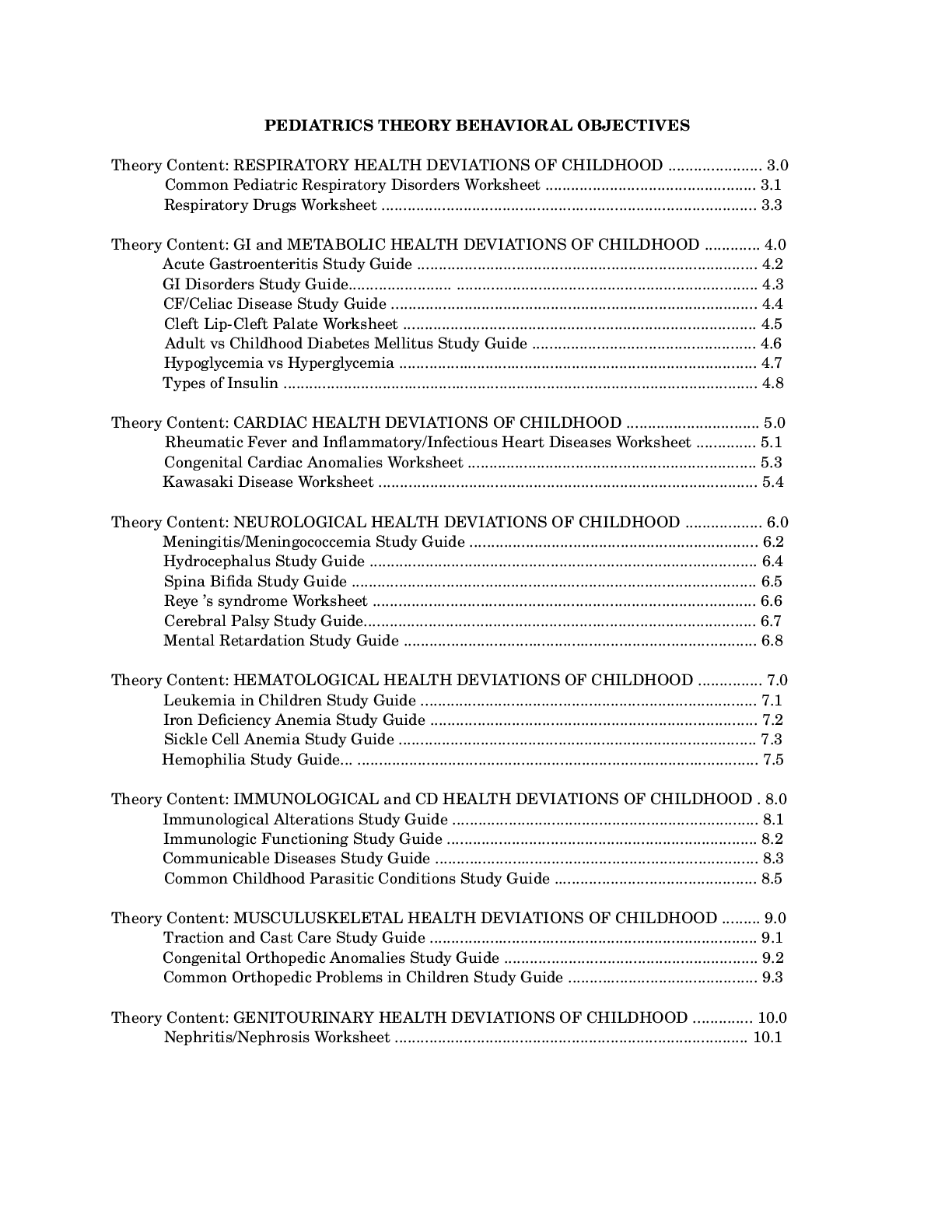
Reviews( 0 )
Document information
Connected school, study & course
About the document
Uploaded On
Jun 17, 2021
Number of pages
15
Written in
Additional information
This document has been written for:
Uploaded
Jun 17, 2021
Downloads
0
Views
108

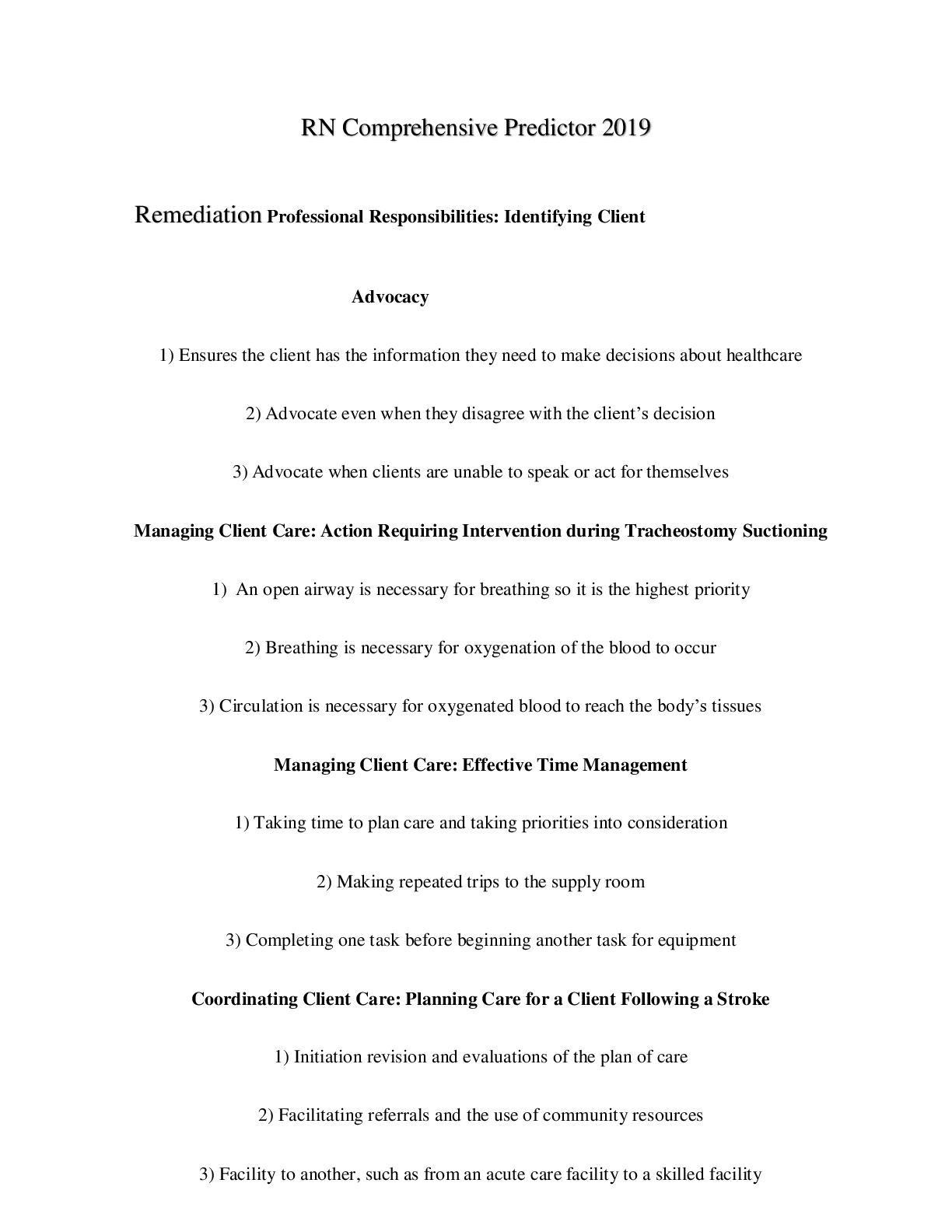
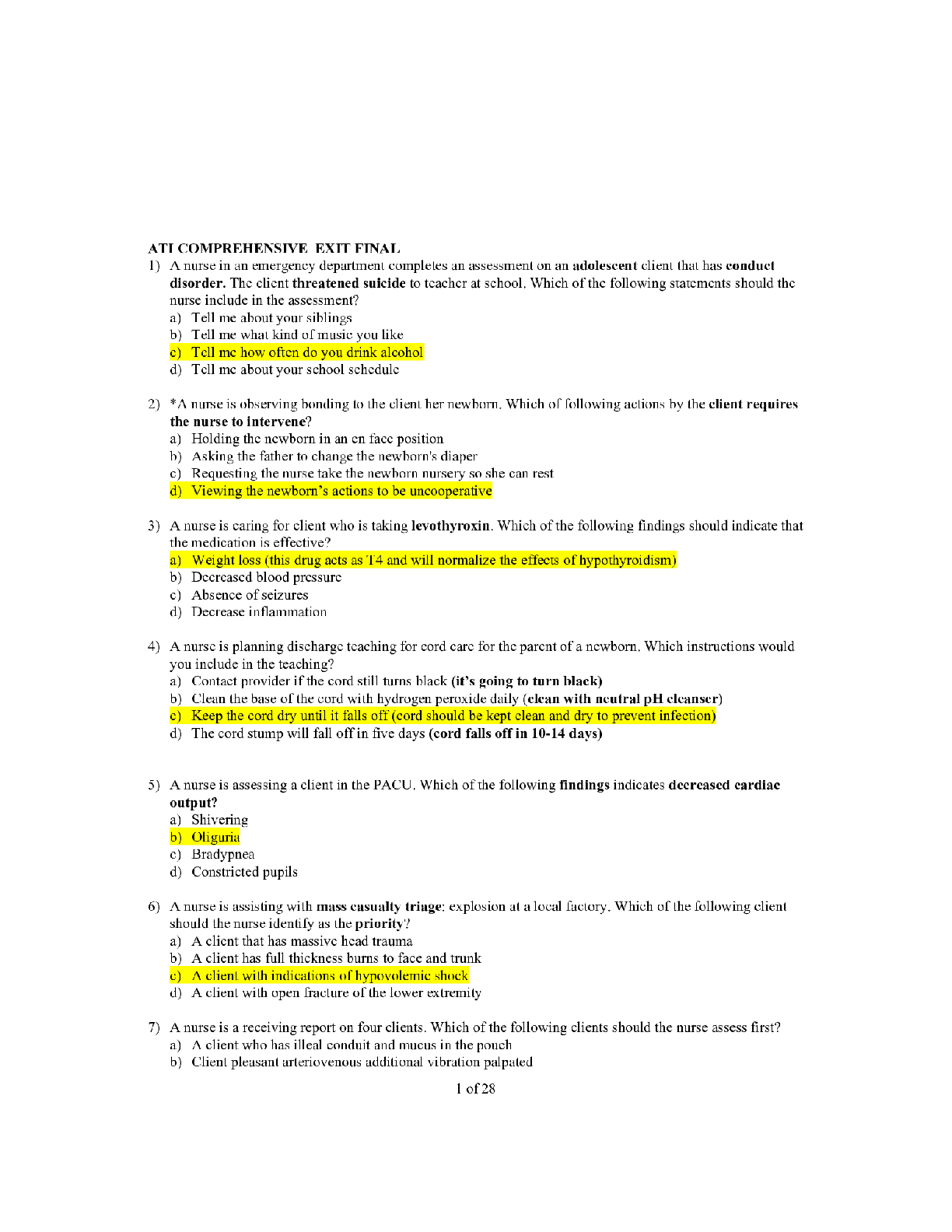
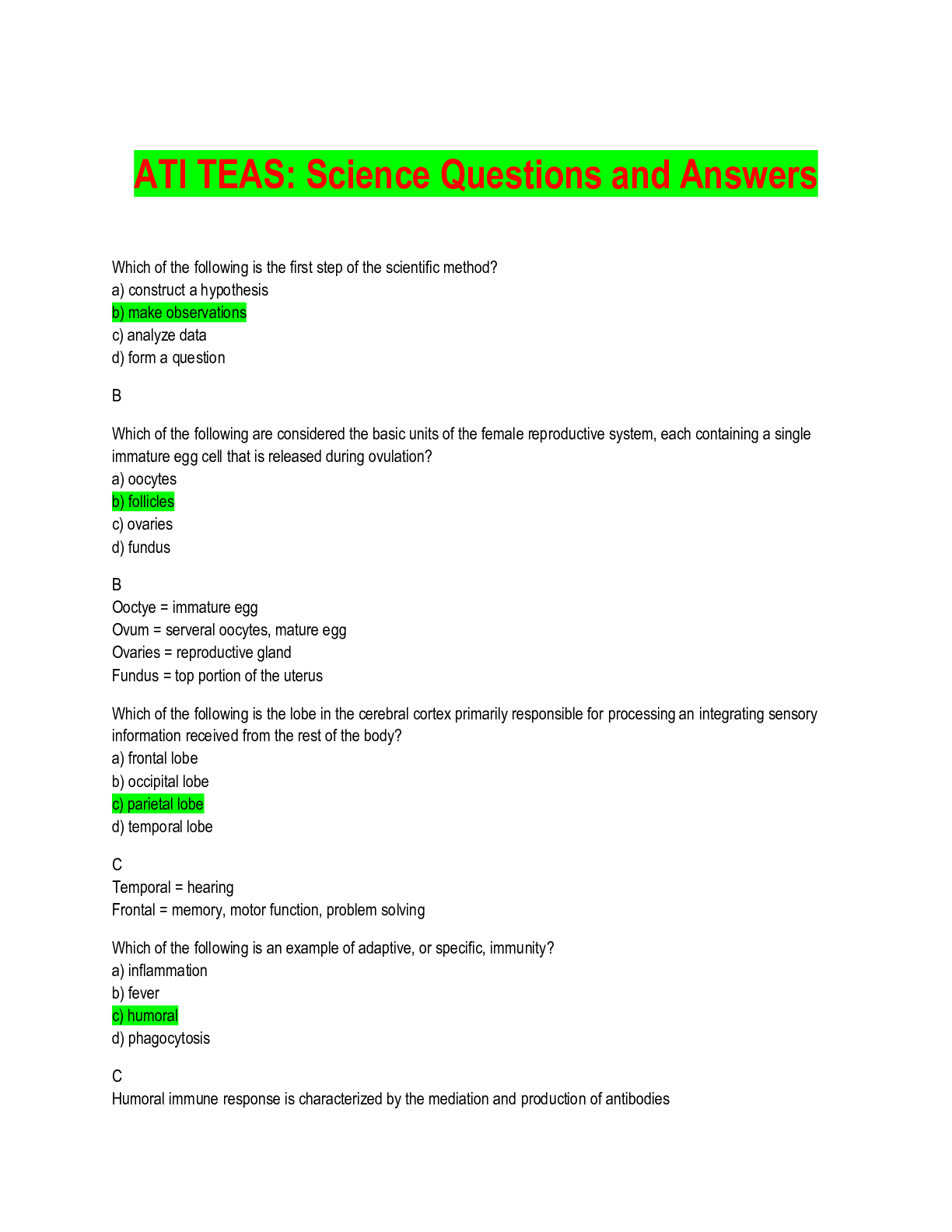
.png)
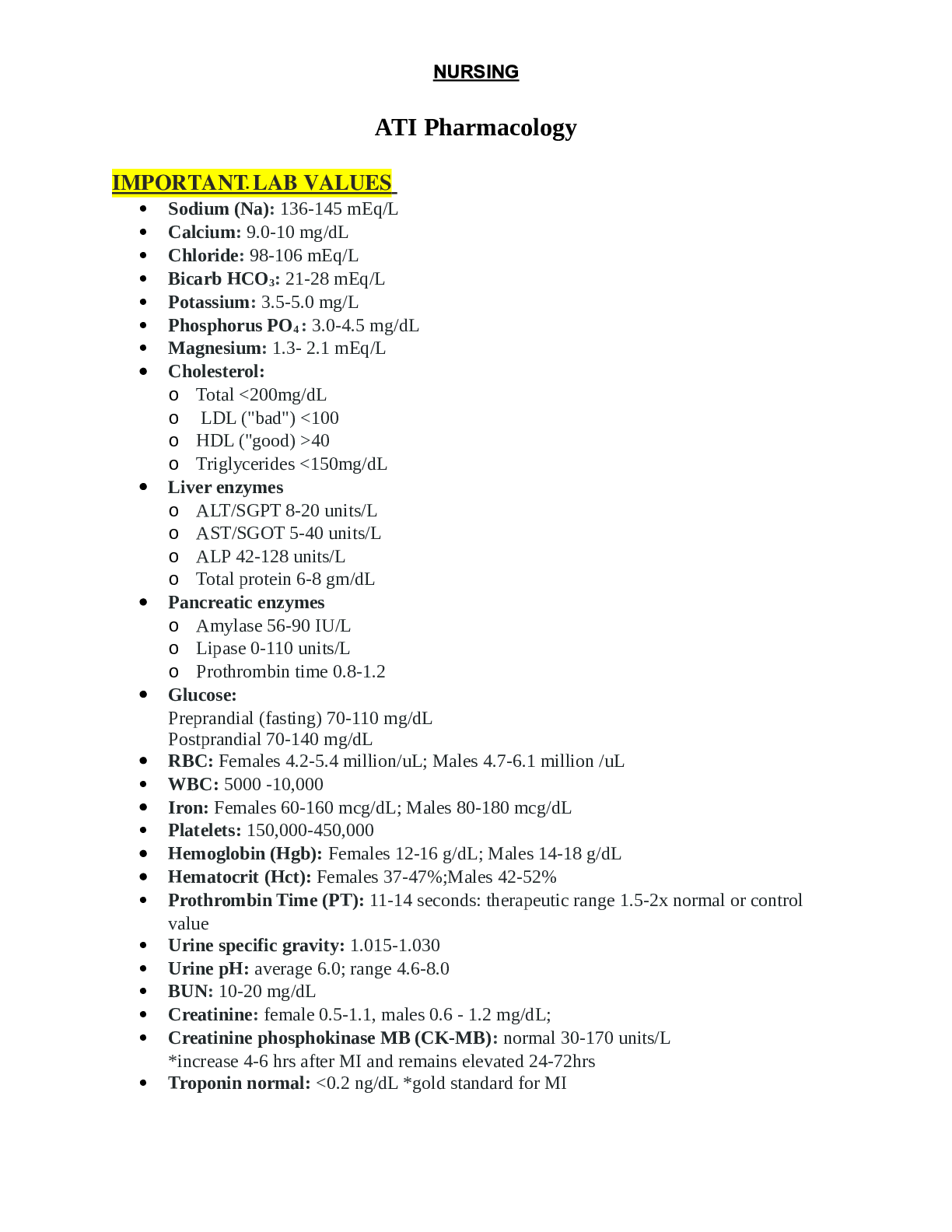

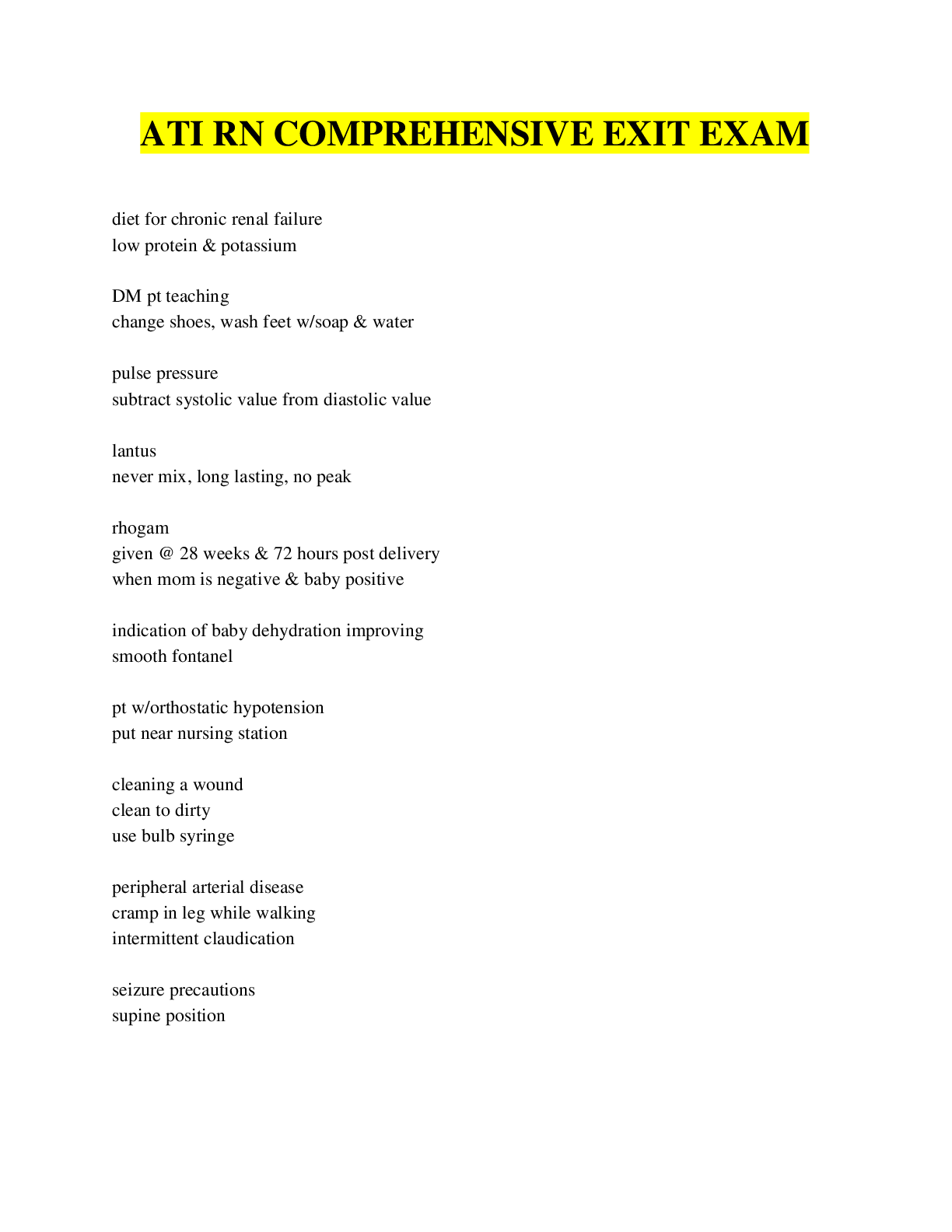
.png)
